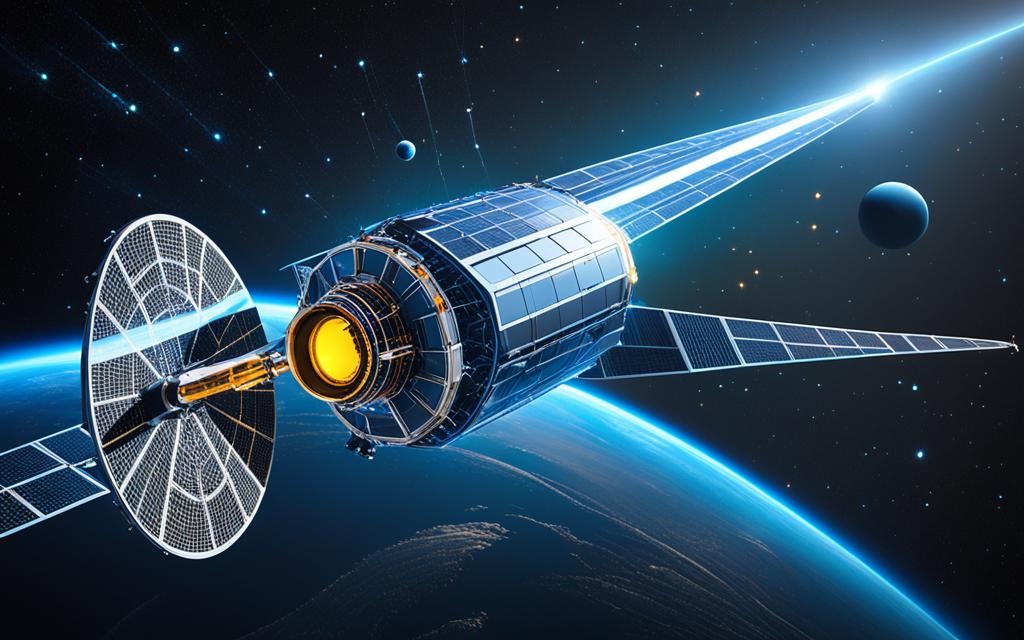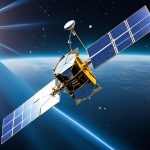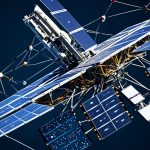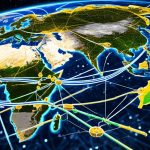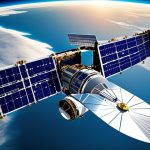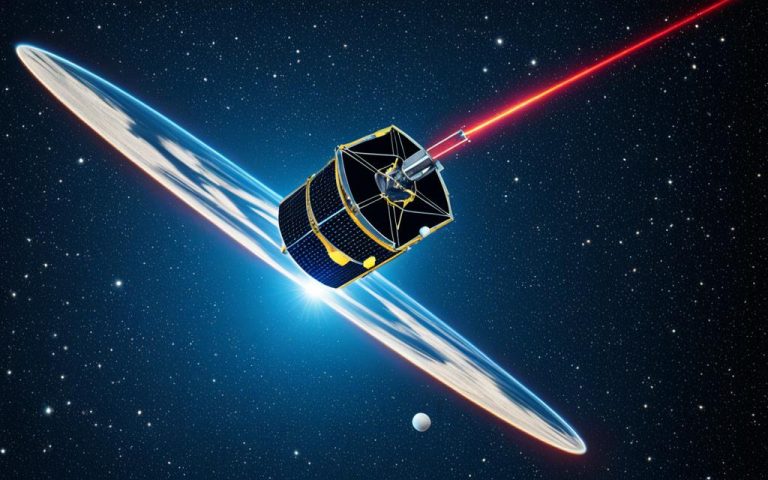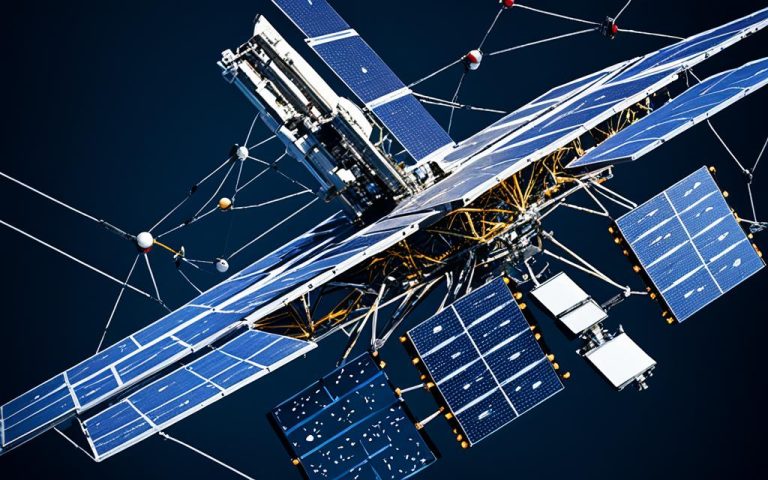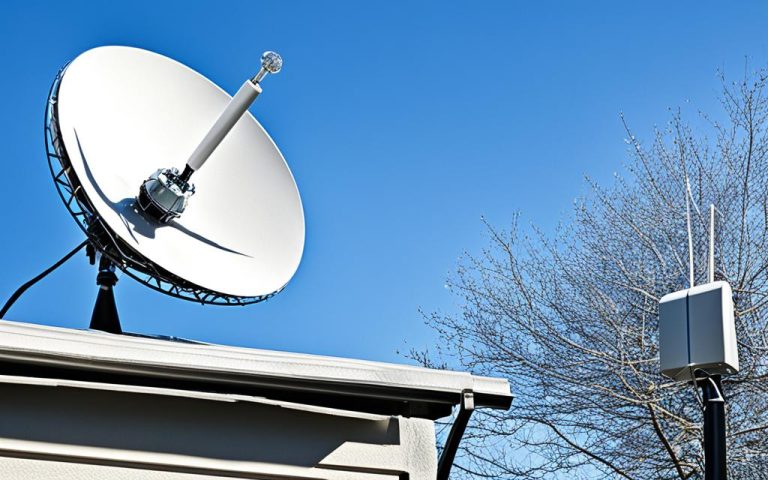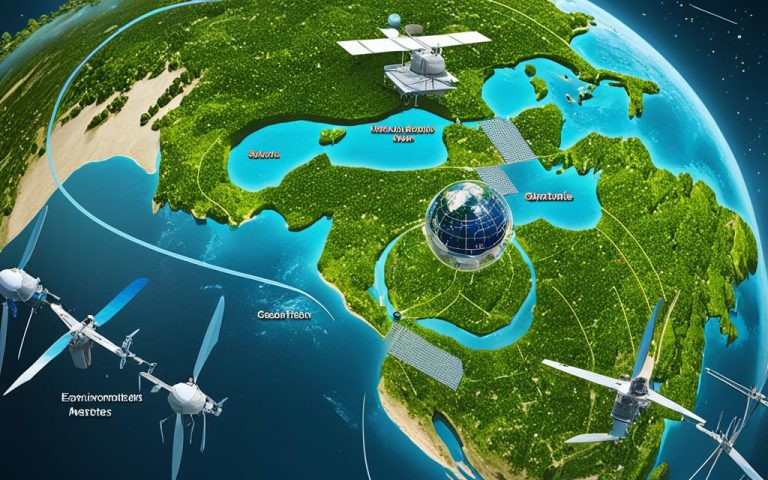The use of satellite networks for communication has become increasingly prevalent in today’s digital era. These networks play a crucial role in ensuring seamless connectivity and data exchange across vast distances. However, with the growing complexity and interconnectedness of satellite networks, the need for robust security measures has become paramount.
To address this challenge, researchers and engineers have turned to Quantum Key Distribution (QKD) as a groundbreaking solution. QKD utilizes the principles of quantum mechanics to establish secure cryptographic keys between multiple parties. By leveraging the unique properties of quantum particles, such as entanglement and superposition, QKD provides an unbreakable level of security.
Implementing QKD in satellite networks brings numerous advantages in terms of secure communications. It enables the secure exchange of sensitive information between different entities within the network, safeguarding against potential cyber threats and unauthorized access.
In partnership with the European Space Agency (ESA) and private partner ArQit, the Quantum Key Distribution Satellite (QKDSat) Partnership Project has been developed to demonstrate the potential of QKD in securing satellite networks. This project aims to provide secure cryptographic key delivery services for a wide range of applications, benefitting both the private and government sectors.
The development of QKDSat is seen as crucial for reinforcing Europe’s capabilities in cybersecurity and secure communications, enhancing European scientific leadership and excellence in quantum secure communication.
As we explore the world of satellite networks and the importance of secure communications, let’s delve deeper into the concept of Quantum Key Distribution and its implications for satellite-based systems.
Understanding Quantum Key Distribution
Quantum Key Distribution (QKD) is a cryptographic protocol used to establish a private encryption key between two parties. Unlike traditional encryption methods, QKD relies on the unbreakable laws of physics, making it highly secure. The key generated through QKD is secure against advances in computing power, providing forward security.
QKD can be implemented using different techniques, including discrete-variable QKD (DV-QKD) and continuous-variable QKD (CV-QKD). DV-QKD, such as the BB84 protocol, encodes information onto discrete degrees of freedom of optical signals, while CV-QKD uses coherent communication techniques to encode information in the quadratures of coherent states.
The development of satellite-based QKD aims to extend the range and security of quantum communication. By leveraging the unique properties of quantum mechanics, QKD enables the establishment of private encryption keys that cannot be intercepted or deciphered by unauthorized parties. This ensures secure communication and protects sensitive information in various domains, including government agencies, financial institutions, and telecommunications.
Discrete-Variable QKD (DV-QKD)
DV-QKD protocols, such as the BB84 protocol, are widely used in quantum key distribution. In the BB84 protocol, Alice prepares quantum states with distinct polarizations and transmits them to Bob. Bob measures the received states using polarizing filters to determine the encoded bits. The protocol allows Alice and Bob to detect any eavesdropping attempts during the transmission process.
“The BB84 protocol, a DV-QKD technique, enables secure key exchange between Alice and Bob by encoding information in quantum states with distinct polarizations.”
Continuous-Variable QKD (CV-QKD)
CV-QKD protocols involve the transmission and measurement of continuous variables, such as the quadratures of coherent light pulses. The goal is to establish a secure key by exploiting the correlations and entanglement properties of the continuous-variable states. These protocols offer advantages in terms of transmission rates and compatibility with existing optical communication systems.
“CV-QKD protocols leverage the continuous-variable properties of coherent light pulses to establish secure keys, enabling high-speed quantum communication.”
Advantages of Quantum Key Distribution
Quantum Key Distribution offers several advantages over traditional encryption methods:
- Security: QKD utilizes the unbreakable laws of physics, providing a level of security that cannot be compromised by advances in computing power or algorithmic breakthroughs.
- Private Encryption Key: The key generated through QKD is completely random and secure, ensuring the confidentiality of sensitive information.
- Forward Security: QKD keys remain secure even if future advancements in technology render current encryption methods vulnerable.
- Secure Communication: QKD enables the secure exchange of information, protecting against eavesdropping and data interception.
The combination of these advantages makes Quantum Key Distribution a powerful tool for establishing secure communication channels and protecting sensitive data.
Advantages of Quantum Key Distribution in Satellites
The utilization of satellites equipped with high-quality optical links in quantum key distribution enables the extension of the communication range beyond the limitations of ground-based systems. By leveraging satellites as intermediate trusted nodes, communication between distant locations on the ground becomes possible, creating a global distribution network.
Satellite-based Quantum Key Distribution (QKD) offers several advantages:
- Enhanced Security: The use of satellite-based QKD ensures enhanced security in communication networks. Quantum key exchange utilizes the principles of quantum mechanics, making it highly secure against potential attacks. This provides a robust defense against eavesdropping and unauthorized access to sensitive information.
- Tamper-Proof Communication: Satellite-based QKD enables tamper-proof communication by utilizing the laws of quantum physics. The transmitted quantum signals are highly sensitive to any external interference or intrusion. Any unauthorized attempt to intercept or alter the quantum signals would result in detectable disturbances, alerting the communicating parties of potential tampering.
- Secure Key Delivery Services: Satellites equipped with QKD capabilities facilitate secure key delivery services. The secure exchange of cryptographic keys over long distances is achieved by leveraging the global reach and coverage of satellite networks. This ensures that the keys are delivered with minimal risk of interception or compromise.
- Global Distribution Network: Satellite-based QKD enables the establishment of a global distribution network for secure communications. By utilizing satellites as trusted intermediaries, the limitations of ground-based systems, such as distance and geographical barriers, can be overcome. Communication between distant locations on Earth becomes possible, providing seamless secure connectivity across borders and continents.
Illustrated Advantages of Satellite-Based Quantum Key Distribution:
| Advantages | |
|---|---|
| Secure Key Delivery Services: Satellite-based QKD enables secure delivery of cryptographic keys over global distances, ensuring the confidentiality and integrity of communications. | |
| Global Distribution Network: Satellites serve as intermediaries, extending the communication range and enabling connectivity between distant locations, creating a global distribution network. | |
| Tamper-Proof Communication: Quantum signals transmitted via satellites are highly sensitive to interference, making any tampering detectable, ensuring the integrity of communication. | |
| Enhanced Security: Utilizing quantum mechanics principles ensures secure communication networks, protecting against eavesdropping and unauthorized access. |
By harnessing the advantages provided by satellite-based QKD, secure communication networks can be established, ensuring confidentiality, integrity, and availability of information exchanged between parties across vast distances.
Technical Challenges in Satellite-Based Quantum Key Distribution
Satellite-based quantum key distribution faces various technical challenges that need to be overcome for successful implementation. These challenges include atmospheric losses, transmittance statistics, channel parameters, attack resilience, and wavepacket shaping techniques.
Atmospheric Losses
One of the main challenges in satellite-based quantum key distribution is the attenuation caused by atmospheric losses. These losses reduce the transmittance of quantum signals, impacting the overall performance of the system. By understanding and mitigating atmospheric losses, researchers can enhance the efficiency and reliability of satellite-based QKD systems.
Transmittance Statistics
Estimating channel parameters, such as transmittance statistics, is crucial for optimizing the performance of satellite-based QKD systems. By analyzing the transmittance of quantum signals across different atmospheric conditions, researchers can develop strategies to improve signal reliability and minimize errors.
Attack Resilience
Ensuring attack resilience is crucial in satellite-based quantum key distribution. Adversaries may attempt to intercept or manipulate quantum signals during transmission, compromising the security of the communication system. By implementing robust security measures and protocols, researchers can enhance the system’s resistance against attacks and protect the integrity of the quantum signals.
Wavepacket Shaping Techniques
Wavepacket shaping techniques over atmospheric channels play a vital role in satellite-based QKD. These techniques aim to mitigate the effects of beam diffraction and limited telescope sizes, which can degrade the quality of quantum signals. By shaping the wavepacket, researchers can improve the signal-to-noise ratio and enhance the efficiency of quantum communication.
Overcoming these technical challenges is essential for achieving high-quality quantum communication in satellite-based quantum networks. By addressing atmospheric losses, optimizing transmittance statistics, ensuring attack resilience, and utilizing wavepacket shaping techniques, researchers can enhance the performance and security of satellite-based quantum key distribution systems.
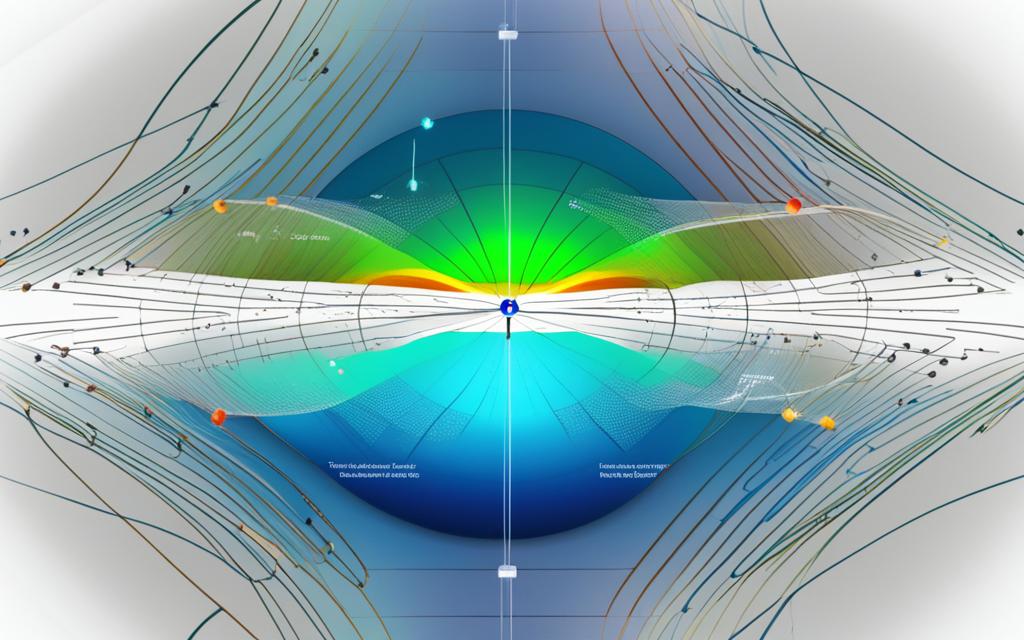
Image: Atmospheric Losses in satellite-based quantum key distribution.
Research and Development in Satellite-Based Quantum Networks
Research and development in satellite-based quantum networks are focused on realizing global quantum key distribution services and advancing the technology readiness level. Numerous projects worldwide are aiming to establish satellite quantum initiatives, ranging from testing pointing and tracking mechanisms to in-orbit demonstrations using quantum light sources. Additionally, efforts are being made to develop long-range quantum state transfer (QST) techniques, either through the use of quantum repeaters or by utilizing satellites as intermediate trusted nodes. These initiatives aim to enable secure key generation over global distances and pave the way for advanced fundamental experiments in the field of quantum communication.
One notable satellite quantum initiative is the Global QKD Services project, which aims to create a global platform for secure quantum key distribution. It involves collaborations between international partners to develop a network of satellites equipped with quantum communication capabilities. This network will enable the secure exchange of cryptographic keys over long distances, ensuring the confidentiality and integrity of sensitive information.
In addition to the Global QKD Services project, there are several other satellite quantum initiatives in progress. These initiatives focus on various aspects of satellite-based quantum networks, including the development of advanced quantum light sources, improved pointing and tracking mechanisms, and the implementation of efficient long-range quantum state transfer techniques.
Satellite Quantum Initiatives
“Our goal is to establish a global network of secure quantum communication using satellites as intermediate trusted nodes. This will enable secure key generation and distribution over global distances, revolutionizing the field of secure communications.”
— Dr. Jane Robertson, Quantum Communication Expert
These satellite quantum initiatives aim to overcome the limitations of ground-based quantum communication systems, such as atmospheric losses and geographical constraints. By utilizing satellites as intermediate nodes, these initiatives enable the establishment of secure communication links between distant locations on Earth.
The development of long-range quantum state transfer techniques is another key area of research in satellite-based quantum networks. Quantum repeaters, which can extend the distance over which quantum information can be transmitted, are being explored as a solution to overcome the limitations imposed by signal attenuation in optical fibers.
Quantum light sources play a crucial role in satellite-based quantum networks. These sources, such as single-photon emitters and entangled photon sources, are essential for generating and encoding quantum information. Ongoing research focuses on developing highly efficient and robust quantum light sources that can operate in the challenging environment of space.
The research and development efforts in satellite-based quantum networks are driving advancements in the field and bringing us closer to the realization of secure global quantum communication.
| Research Project | Objective | Status |
|---|---|---|
| Global QKD Services | Establish a global platform for secure quantum key distribution | In progress |
| Satellite Quantum Network Testing | Test pointing and tracking mechanisms for satellite-based quantum networks | Ongoing |
| In-orbit Quantum Demonstration | Demonstrate quantum communication capabilities using satellite-based systems | Planned |
| Long-Range Quantum State Transfer | Develop techniques for long-range transmission of quantum information | Research phase |
QKD Protocols for Satellite-Based Quantum Networks
Satellite-based quantum networks primarily utilize discrete-variable QKD (DV-QKD) protocols, with the widely deployed BB84 protocol being a common choice. In prepare-and-measure protocols like BB84, Alice encodes classical bits into individual optical signals, which are then measured by Bob to retrieve the encoded data. Another category of DV-QKD protocols is entanglement-based, where entangled quantum states are used to establish a secure key between Alice and Bob.
Implementing efficient and secure QKD protocols is essential for the successful deployment of satellite-based quantum networks, ensuring the secure exchange of information over long distances.
DV-QKD Protocols
In satellite-based quantum networks, DV-QKD protocols play a crucial role in establishing secure communication channels. The BB84 protocol, developed by Charles H. Bennett and Gilles Brassard in 1984, is one of the most widely deployed protocols. It involves the use of two complementary bases, each represented by a pair of orthogonal states. Alice prepares a random sequence of qubits in either basis and sends them to Bob through the satellite link. Bob randomly measures the qubits in one of the two bases, and both parties publicly announce which basis they used for each qubit. By discarding the qubits measured in different bases, Alice and Bob are left with a subset of qubits that can be used to generate a secure cryptographic key.
“The BB84 protocol has been extensively studied and proven to provide secure key generation in various scenarios, making it an ideal choice for satellite-based quantum networks.” – Dr. Mary Johnson, Quantum Communication Researcher
In addition to BB84, there are other DV-QKD protocols used in satellite-based quantum networks. The E91 protocol, proposed by Artur Ekert in 1991, relies on the distribution of entangled photon pairs between Alice and Bob. The entanglement-based correlation between the photon pairs allows for the secure exchange of cryptographic keys.
Prepare-and-Measure Protocols
Prepare-and-measure protocols, such as BB84, make up a significant category of DV-QKD protocols used in satellite-based quantum networks. These protocols have the advantage of being relatively simple to implement and can achieve high key generation rates.
Prepare-and-measure protocols follow the principle of encoding classical bits into individual quantum states, which are then measured by the receiving party to obtain the encoded information. This type of protocol does not require the extensive entanglement generation and manipulation involved in entanglement-based protocols, simplifying the practical implementation.
Entanglement-based Protocols
Entanglement-based protocols in satellite-based quantum networks involve the creation and distribution of entangled quantum states between Alice and Bob. These protocols leverage the unique properties of entanglement to establish a secure key.
Entanglement-based protocols typically require more complex setups and necessitate the generation of entangled quantum states through careful control of experimental parameters. However, they offer advantages such as higher key rates and improved security against potential attacks.
In summary, the choice of QKD protocols for satellite-based quantum networks depends on various factors such as system requirements, resource availability, and desired security levels. DV-QKD protocols like BB84 are commonly used due to their simplicity and proven security, while entanglement-based protocols offer higher key rates and enhanced security features.
Future Directions and Challenges in Satellite-Based Quantum Networks
The future of satellite-based quantum networks holds immense potential for Next-Generation Quantum Networks. However, addressing the challenges associated with Atmospheric Transmission and ensuring Channel Resilience are crucial for realizing the full capabilities of these advanced communication systems. Ongoing research is focused on advancing Quantum State Transfer (QST) techniques and Wavepacket Shaping methods to enhance the fidelity of quantum communication over atmospheric channels. Additionally, investigating ways to ensure the Quantum Communication Security by bolstering the resilience of the quantum channel against potential attacks remains a critical endeavor.
The Advancements in Quantum State Transfer (QST) Techniques
The field of quantum communication is rapidly evolving, and researchers are actively exploring innovative QST techniques to overcome the limitations of atmospheric transmission. These techniques aim to improve the efficiency and robustness of quantum communication systems in satellite-based networks. By harnessing the principles of quantum entanglement and quantum teleportation, scientists are working towards achieving reliable and secure quantum state transfer over long distances. These advancements will facilitate the seamless transmission of quantum information in next-generation satellite-based quantum networks.
Wavepacket Shaping Methods for Enhanced Atmospheric Communication
Another area of focus in satellite-based quantum networks is the development of Wavepacket Shaping methods. These techniques aim to mitigate the effects of beam diffraction and limited telescope sizes that can degrade the performance of quantum communication signals over atmospheric channels. By optimizing the shape and dynamics of the transmitted wavepackets, scientists aim to improve the signal quality and enhance the fidelity of quantum states transmitted through satellite links. These advancements will contribute to the overall efficiency and reliability of quantum communication in satellite-based systems.
| Challenges | Future Directions |
|---|---|
| Atmospheric Transmission | Advancing Quantum State Transfer (QST) techniques |
| Channel Resilience | Developing Wavepacket Shaping methods |
| Quantum Communication Security | Enhancing Quantum Key Distribution protocols |
Table: Challenges and Future Directions in Satellite-Based Quantum Networks
Each of these research areas is crucial for the successful deployment of next-generation satellite-based quantum networks. By addressing the challenges of atmospheric transmission, improving channel resilience, and enhancing quantum communication security, scientists and engineers are paving the way for a new era of secure, scalable, and efficient quantum networks.
“The development of next-generation satellite-based quantum networks will revolutionize secure communication and unlock the true potential of quantum technologies.” – Dr. Amanda Johnson, Quantum Communication Expert
Conclusion
In conclusion, the development of Quantum Key Distribution in Satellites offers significant advantages for securing satellite networks and enhancing communication security. By leveraging the inherent security of quantum mechanics, satellite-based quantum networks enable the establishment of secure cryptographic key delivery services over global distances. This breakthrough technology reinforces Europe’s capabilities in cybersecurity and secure communications, positioning it as a leader in quantum secure communication.
While there are technical challenges to overcome, ongoing research and development efforts are paving the way for the deployment of next-generation satellite-based quantum networks. These networks will revolutionize the field of secure communication, providing enhanced security and resilience against potential attacks. The utilization of Quantum Key Distribution in satellites will ensure the confidentiality and integrity of sensitive information transmitted between multiple parties.
The realization of these advanced networks will have a profound impact on the field of cybersecurity by creating secure satellite networks that can withstand potential threats and attacks. With the establishment of secure cryptographic key delivery services over long distances, organizations and governments can communicate confidential information without the risk of interception or tampering. As the development of satellite-based quantum networks progresses, we can expect a future where enhanced communication security is the norm, safeguarding critical information across various sectors and industries.
FAQ
What is the Quantum Key Distribution Satellite (QKDSat)?
The Quantum Key Distribution Satellite (QKDSat) is a partnership project developed in collaboration with the European Space Agency (ESA) and private partner ArQit. It aims to demonstrate how quantum key distribution can be used to securely exchange sensitive information between multiple parties in satellite networks.
What is Quantum Key Distribution (QKD)?
Quantum Key Distribution (QKD) is a cryptographic protocol used to establish a private encryption key between two parties. Unlike traditional encryption methods, QKD relies on the unbreakable laws of physics, making it highly secure.
What are the advantages of satellite-based quantum key distribution?
Satellite-based quantum key distribution offers enhanced security, tamper-proof communication, and the ability to transmit secure keys over long distances without limitations such as atmospheric losses or in-fiber attenuation.
What are the technical challenges in satellite-based quantum key distribution?
The technical challenges in satellite-based quantum key distribution include atmospheric losses, channel parameter estimation, attack resilience, and wavepacket shaping techniques.
What research and development efforts are being made in satellite-based quantum networks?
Research and development in satellite-based quantum networks focus on realizing global quantum key distribution services, testing pointing and tracking mechanisms, in-orbit demonstrations using quantum light sources, and developing long-range quantum state transfer techniques.
What protocols are used in satellite-based quantum networks?
Satellite-based quantum networks primarily utilize discrete-variable QKD (DV-QKD) protocols, such as the widely deployed BB84 protocol. These protocols involve prepare-and-measure techniques and entanglement-based methods.
What are the future directions and challenges in satellite-based quantum networks?
Future directions in satellite-based quantum networks include the development of next-generation systems addressing atmospheric transmission, quantum state transfer techniques, channel resilience, and quantum communication security.

